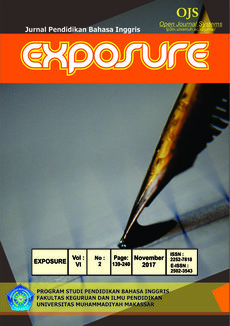THE USE OF PREDICT-EXPLAIN-OBSERVE-EXPLAIN IN IMPROVING THE STUDENTS’ SPEAKING ABILITY
DOI:
https://doi.org/10.26618/exposure.v6i2.1181Keywords:
Predict-Explain-Observe-Explain, Experimental design, speaking accuracy, speaking fluencyAbstract
This research aimed to explain the improved of the students’ accuracy and fluency in speaking. This research employed an Experimental design which was conducted in Pre-Test, Treatment, and Post-Test of five meetings. The location of this research was taken at eleventh year students of SMAN 1 Lilirilau Kabupaten Soppeng with a number of the subject were 35 students. The research findings indicate that the application of Predict-Explain-Observe-Explain was significant in improving the students’ accuracy and fluency in speaking. It was proved by the mean score of Pre-test was 3.48 then improved to be 8.32 in Post-test. And also there was significant because the result of t-test was 26.88 and t-table was 2.042. It mean that there was the improved of the students’ accuracy and fluency in speaking.
References
Arikunto, Suharmisi. 1998. Prosedur Penelitian ( suatu pendekatan praktek). Jakarta: PT.Rineka Cipta
Arsyad, azhar. 2006. Media pembelajaran. Jakarta: PT. Raja Grafindo Persada
Brown, H. Douglas. 1994. Teaching by Principle : An Interactive Approach Language Pedagogy. New York: Prentice-Hall, Inc
Brown in Florez (1999)
http://sibungsuinred.blogspot.com/2011/10/teaching-speaking.html
Byrne, Donn. 1987. Teaching Oral English Singapore. Longman Singapore Publisher.
Chastain. Kenneth. 1976. Developing Second Language Skills; Theory to practice; Third Edition; McNally College Publishing Company
Depdikbud. 1985. Petunjuk pelaksanaan proses belajar mengajar dan petunjuk pelaksanaan system penilaian. Jakarta: Depdikbud
Doff, Adrin. 1998. Teach English, training course for teachers. Australia: Cambridge University
Gay, L. R, 1981. Educational Research: Competencies for Analysis and Application. Columbus: A Bell and Howell Company, Charles, E. Merril Publishing Co
Heaton, J.B.1989. Writing English Language Test. New York: Longman Group UK Company
Harmer, J. 1991. The Practice of English Language Teaching London an New York. Longman Group
Liew, Wah. 2004. The Effectiveness Predict-Explain-Observe-Explain Technique in Diagnosing Student's Understanding of Their scienceand Identifying Level of Achievement. Africa: University of Natal
Sangkala, I. (2012, May). The Implementation of "ARIAS" Strategy to Increase Students Speaking Skill at SMA Negeri 1 Bungoro. Exposure, 1(1), 59-76. doi:http://dx.doi.org/10.26618/ejpbi.v1i1
Sudjana, N., Rivai, A. 1999 Media pembelajaran. Bandung: PT. Tarsito
Sudjana, N. 1982. Metode statistika. Bandung : PT. Tarsito
Webster’s. 1959. Third New International Dictionary. A.B., Dartmouth College; A.M., Harrad University; Ph.d., Columbia University
Widowson, H.G. 1985 Teaching Language as Communication. New York; Oxford University Press
Downloads
Published
Issue
Section
License
Authors who publish with this journal agree to the following terms:
In order to assure the highest standards for published articles, a peer review policy is applied. In pursue of the compliance with academic standards, all parties involved in the publishing process (the authors, the editors and the editorial board and the reviewers) agree to meet the responsibilities stated below in accordance to the Journal publication ethics and malpractice statement.
Duties of Authors:
- The author(s) warrant that the submitted article is an original work, which has not been previously published, and that they have obtained an agreement from any co-author(s) prior to the manuscript’s submission;
- The author(s) should not submit articles describing essentially the same research to more than one journal;
- The authors(s) make certain that the manuscript meets the terms of the Manuscript Submission Guideline regarding appropriate academic citation and that no copyright infringement occurs;
- The authors(s) should inform the editors about any conflict of interests and report any errors they subsequently, discover in their manuscript.
Duties of Editors and the Editorial Board:
- The editors, together with the editorial board, are responsible for deciding upon the publication or rejection of the submitted manuscripts based only on their originality, significance, and relevance to the domains of the journal;
- The editors evaluate the manuscripts compliance with academic criteria, the domains of the journal and the guidelines;
- The editors must at all times respect the confidentiality of any information pertaining to the submitted manuscripts;
- The editors assign the review of each manuscript to two reviewers chosen according to their domains of expertise. The editors must take into account any conflict of interest reported by the authors and the reviewers.
- The editors must ensure that the comments and recommendations of the reviewers are sent to the author(s) in due time and that the manuscripts are returned to the editors, who take the final decision to publish them or not.
Authors are permitted and encouraged to post online a pre-publication manuscript (but not the Publisher’s final formatted PDF version of the Work) in institutional repositories or on their Websites prior to and during the submission process, as it can lead to productive exchanges, as well as earlier and greater citation of published work (see The Effect of Open Access). Any such posting made before acceptance and publication of the Work shall be updated upon publication to include a reference to the Publisher-assigned DOI (Digital Object Identifier) and a link to the online abstract for the final published Work in the Journal.

